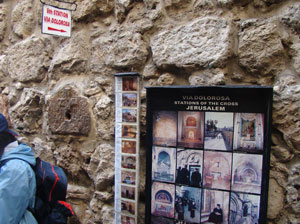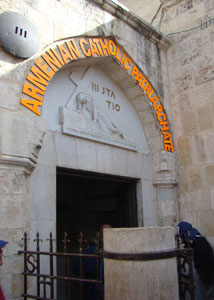The experience of a pilgrimage to the Holy Land of Israel is indescribable. The reverence and awe of walking along the Via Dolorosa, or the Way of Suffering in Jerusalem, following in the footsteps of Jesus Christ, as he walked - mocked, bloodied and carrying a heavy cross, from the place he was sentenced to his crucifixion in Calvary, is a never-to-be forgotten experience.
The 11.4 kilometres of the Via Dolorosa is followed by Christians of many denominations and is marked by 14 Stations of the Cross, passing through the Moslem and Christian Quarters of Jerusalem. Nine of the Stations are situated along busy narrow alleys and the last five are inside the Church of the Holy Sepulchre.
 |
| Station 8: A cross and Greek inscription mark the spot where Jesus consoled the sorrowing women of Jerusalem |
Each Station is marked with a plaque, which can be difficult to spot. Although the exact location of each event may be in doubt, this is of little importance to pilgrims; the pilgrimage is meaningful because of its proximity to the original events and the reflection afforded along the way.
But the Via Dolorosa is a difficult place for prayer and contemplation since it traverses busy streets lined with eateries, tourist shops and vendors thrusting supposed religious artifacts and souvenirs at the unwary pilgrim.
The First station is west of the Lion's Gate and used to be in the Praetorium in the Antonia Fortress, the headquarters of the Roman garrison, where Jesus was tried and condemned by Roman Consul Pontius Pilate and the Sanhedrin, supported by a hostile crowd. It now houses the al-Omariya school. Travelling back in time we wonder at the hate of a people that condemned to the worst form of death, by crucifixion, an innocent man whom they had just recently cheered into the city. We reflect on the fickleness of the public adulation we crave so often.
Across the road, Station 2 commemorates the place at which Jesus took up his cross and the site at which he was brutally scourged by Roman soldiers. The Chapel of Condemnation, on the left marks the site where he was sentenced to death.
Most evocative are three stained glass windows that depict the victory cry of Barabbas, the murderer freed in Jesus’ stead, the whipping of Jesus wearing the crown of thorns amidst the soldiers, and Pilate washing his hands to absolve himself from sin.
In the days of the Roman empire, a convicted person was forced to carry an agonizingly heavy cross as a deterrent for all to see and fear. To carry a cross meant that all hope of a reprieve was lost.
By bearing the cross, Jesus, the sinless Lamb of God, took upon Himself the sins of the entire world- those already committed and to be committed in the future - and became himself the embodiment of sin because of his amazing love for mankind that defies human understanding.
The Romans had made torture into a fine art. Scourging of a person soon to be crucified was done with whips that cut strips of flesh from the victim's body and nail studded clubs that raked through his back, ripping out pieces of flesh.
The Via Dolorosa then passes the northwestern gate of the Temple Mount, Bab al-Ghawanima. Ahead is the Convent of the Sisters of Zion, which contains large pieces of the Lithostratos stone slabs, the squares and triangles on these slabs were made by game-playing Roman soldiers and brings to life the Gospel account of soldiers gambling for Jesus' clothes at his crucifixion.
Station 3 is where Jesus falls for the first time under the weight of the cross. The site has a 15th century Armenian Catholic church built in commemoration. The sculpture by Thaddeus Zielinsky at its entrance on El-Wad Street depicts Jesus’ fall.Jesus’ falling reminds us of the immense weight of the sins of the world that he took on Himself to bear in order to reconcile mankind with God.
At Station 4, Mary watches her son go by with the cross. This is commemorated by the Armenian Church of Our Lady of the Spasm. The 5th-century floor mosaic inside has an outline of a pair of sandals, traditionally believed to be the spot at which Mary stood as her son passed by. One reflects on the grief of a mother who witnessed her son’s rejection, agony and subsequent crucifixion. Despite knowing that her son had a greater purpose to fulfil, she is at heart a mother, experiencing a piercing sorrow that no parent should have to bear.
 |
| Station 3: The Armenian Catholic Church on the spot where Jesus fell under the weight of the cross.
Pix by Romano Pereira |
At Station 5, Simon of Cyrene was forced by Roman soldiers to help Jesus carry the cross. This is located at the corner where the Via Dolorosa turns west off al-Wad Road and narrows as it goes uphill to Golgotha. The Franciscan Chapel of Simon of Cyrene was built in 1895. On the right side of the entrance is a rock with an indentation traditionally believed to have been made when Jesus, bruised, bloodied and in intense pain, leaned on it to steady himself under the back- breaking weight of the cross.
Although Jesus Christ was God and Creator of the world, we are reminded at this Station of the complete mortality that he voluntarily took upon himself while walking this earth, and so experienced all the emotions and frailties of the human body, to present himself as a perfect sacrifice to redeem the world of sin.
Station 6 is at the top of a steep hill where, according to tradition, Veronica wiped Jesus' face with her handkerchief, leaving an image of his face imprinted on the cloth, which is kept at St. Peter's Basilica, Rome. The Church of the Holy Face, served by the “Little Sisters”, a Greek Catholic order, stands here. The chapel is part of the Crusader monastery of St. Cosmos in the 6th century and was renovated by architect Antonio Barluzzi in 1953.
At Station 7, Jesus fell for a second time as he passed along the streets of Jerusalem on his way to Calvary. This is marked by a Franciscan chapel at the junction of Souq Khan al-Zeit.
Here we are once again reminded of the price paid for our sins by the suffering Saviour, a price beyond human valuation, a fact to remember when faced with the temptation to sin.
Station 8 is across the market street and up the steps of Aqabat al-Khanqah. A cross and the Greek inscription "NIKA" (Jesus is victorious) on the wall of the Greek Orthodox Monastery of St. Charalambos mark the place where Jesus consoled the lamenting women of Jerusalem. He leaves aside his pain and suffering to comfort them, telling them to weep not for Him but for themselves and future generations as he prophesies the destruction of Jerusalem.
A long and involved route across Souq Khan al-Zeit, and up 28 stone steps leads to Station 9 at the Coptic Patriarchate next to the Church of the Holy Sepulchre. Here, a Roman pillar marks the site of Jesus' third fall as the exhausted Lord falters again under the burden of the heavy cross.
The pain and suffering of the Saviour is brought vividly to mind and we dwell on our sins that weigh down the Sinless One whose unfathomable love for us made him voluntarily bear this agony.
Stations 10 to 14 are inside the Basilica of the Holy Sepulchre. To get to its entrance from Station 9, head south down Souq Khan al-Zeit to the end and right into Souq al-Dabbagha.
Station 10 commemorates Jesus being stripped by the Roman soldiers. The Chapel of the Divestiture is at the top of a stone staircase. Here Jesus once more takes on the condition of fallen man. Not only is he put through pain and suffering, he is publicly humiliated and stripped of all dignity.
Station 11 is where Jesus was nailed to the cross and is located upstairs, at the Latin Calvary. Magnificent mosaics decorate this site.
Roman soldiers drove in nails through Jesus’ hands and feet at the points at which the nerves meet, causing excruciating pain.
We stand before the dying Lord, who did not use his power to come down from the Cross but endured its suffering to the end. We realize the superficiality of the fleeting pleasures of sin. We look upon him in our times of tribulation and realize that it is then that we are closest to God.
Station 12 recalls Jesus’ death on the cross and houses the Rock of Golgotha in the Greek Orthodox Calvary. A Greek Orthodox altar marks the spot of the cross. Beneath the altar is a silver disc through which pilgrims touch the rock in awe and veneration. Beside this a Roman Catholic altar dedicated to Our Lady of Dolours with a 17th century statue of Mary with a sword piercing her heart recalls the grief of the mother at the torture and death of her son, before her very eyes.
He has now completed the offering of himself. The title above the Crucified Christ remains on public display. He is indeed the king of the world.
In Station 13 Jesus is taken down from the cross. An altar marks the spot where Jesus’ earthly body was taken down from the cross and laid out on the Stone of Unction in preparation for burial.
At this time a great event is taking place in the spiritual realm. Sin was being defeated and Satan’s hold on mankind was being released. Jesus had wiped out our debt by his death.
Finally, we come to Station 14, at the centre beneath the main rotunda, inside the tiny Chapel of the Holy Sepulchre, where Jesus is laid in the tomb.
The Bible records Joseph of Arimathea bringing Jesus to a new, unused tomb. Disgraced and mistreated, the Saviour is honorably laid to rest.
And here we confront the reality of the empty tomb. Here, Jesus triumphs over sin and death by his resurrection three days later. In the words at the Garden Tomb, also in Jerusalem and considered another place at which his body may have lain, ‘HE IS NOT HERE FOR HE IS RISEN.’
Herein lies the essence of Christianity. This is the message of Easter. That the God of Love paid the supreme sacrifice of himself and conquering death, reconciled man with God. He is now risen and reigns forever. ‘Oh death where is thy sting? Oh grave where is thy victory?’ |



